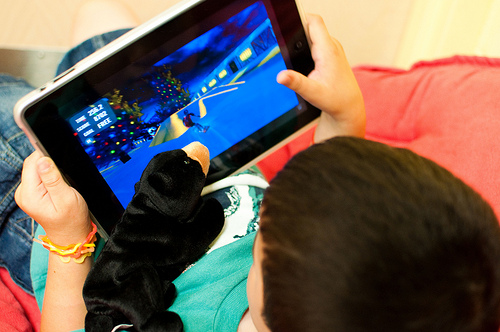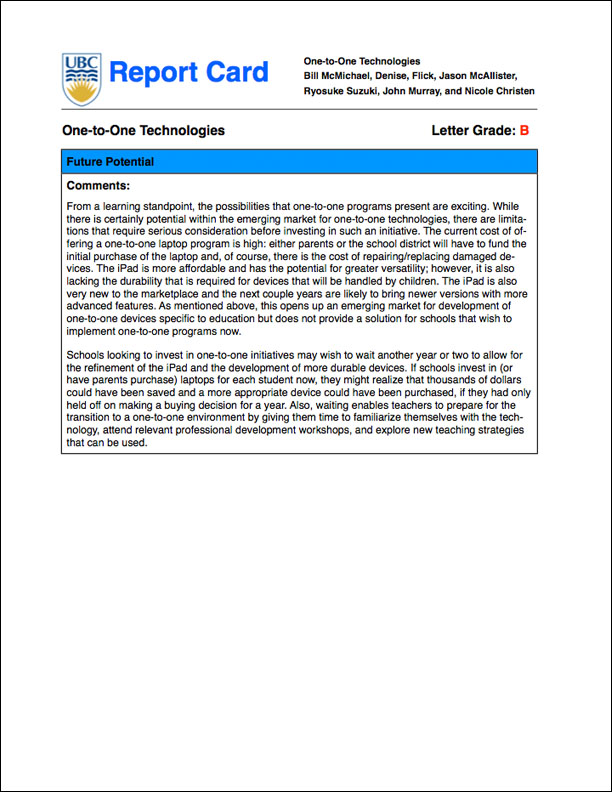Course:ETEC522/2010ST1/OneToOneTechnologies/Potential
Go back to One-to-One Home Page

From an investment standpoint, there are a number of areas with very good development potential within one-to-one technologies. Considering the strength of the North American infrastructure when it comes to wireless access and network capability, alternative forms of learning that use online tools are feasible and present an emerging market. The concept of one-to-one programs within schools is gaining popularity, but is still in its early stages with key obstacles that need to be overcome. Each of the following obstacles presents a venture opportunity where future potential exists:
-Curriculum and Teaching Strategies that Effectively Use One-to-One Technologies
-Durability of One-to-One Devices
-Affordability of One-to-One Initiatives
An Emerging Market for Curriculum Development
Education using one-to-one initiatives needs to utilize unique strategies and tools for learning to provide an educational experience that is different from a traditional classroom. Otherwise, why invest thousands of dollars into a one-to-one laptop program?
Merchant (2009) makes the following statements:
"In introducing these themes, I asked whether we imagine that these technologies will perform old routines more effectively, or whether they can really be transformational. The idea that technologies, or rather our use of technologies, will somehow transform learning and teaching and literacy is written into the policy documentation, but transformational pedagogy needs further elaboration and description, and this work might well begin with an examination of some of the concepts that we, sometimes rather glibly, take for granted." (p.119)
"If formal and informal learning take place in specific kind of structured or semi-structured social networks, then online environments present an alternative range of contexts. These are contexts that or learning spaces that are not so strongly tethered to place and whose temporal boundaries are more flexible than has traditionally been the case. Furthermore, they invite new ways of thinking about the production and circulation of the artifacts of learning, reconfiguring relationships between learners and experts, as well as teachers and their teaching resources. Such shifts in pedagogy are possible, but they are more dependent upon the creativity of educators and the vision of policy-makers than they are on our technological resources of hardware and software." ( pp. 119-120)
Social Media Platforms and Curriculum Development
The learning theory of connectivism suggests that knowledge is obtained by knowing where to look for information and the ability to connect different pieces of information together ("Connectivism (learning theory)", 2010). Web 2.0 applications and social media platforms provide an environment for students to collaborate that is not dependent on physical location. Students in schools that have adopted one-to-one initiatives can begin an assignment in class, with teacher guidance to get them started. The assignment can be then be continued after school hours, without students needing to arrange a face-to-face meeting. Social media channels also provide ways for student to connect with one another via text and video chats to ask one another questions about assignments and seek peer assistance. Bose (2010) provides a theoretical background for the benefits of social learning arguing that collaboration leads to a more thorough learning experience. The use of Web 2.0 applications creates a foundation for collaborative learning and at the same time helps students to learn how to succeed as adults in a society that is relying more and more on networked knowledge (Bose, 2010). Merchant (2009), adds that blogs and other social media platforms facilitate a culture of active citizenship; however, Bose (2010) cautions that teachers must be involved to mediate the process to establish a context for learning and ensure meaningful participation (Bose, 2010).
Therefore, there appear to be educational benefits for using Web 2.0 applications. Students who are learning through one-to-one initiatives should be receiving an education that has marked distinctions from that obtained in a traditional classroom and the use of Web 2.0 tools can facilitate richer educational experiences. Teachers need to be equipped with both knowledge and teaching strategies in order to create effective collaborative learning experiences using Web 2.0 tools in a one-to-one setting. Thus, emerging markets and venture opportunities for Web 2.0 tools designed specifically for students and for curriculum development exist.
Apps and Educational Games
One-to-one initiatives also allow for the use of applications and games to extend the learning experience. Through the iPad, which is decribed below, students are able to access numerous applications that can extend lessons and offer extra help. On a regular laptop, students can visit educational game sites approved by their teacher for extra practice.
One of the challenges teachers in a traditional classroom face is keeping students engaged once they have completed the mandatory assignment for the lesson. In a classroom with one-to-one devices, students can easily continue learning in an enjoyable and relevant way.
To view a few of the applications for the iPad, visit: http://www.isteconnects.org/2010/04/12/ipad-apps-for-education/
An Emerging Market for Durable One-to-One Devices
Project Inkwell
The objective of Project Inkwell is to establish international standards for the manufacture of laptops designed to be used by children in Kindergarten through Grade 12. The specifications for Inkwell devices enables them to better withstand regular student use and decreases the need for repair due to rough handling by students. Read the "Inkwell Functional Requirements for Student Devices 1.0": http://www.projectinkwell.com/docs/Inkwell_Specs.pdf.
Currently on the Market
HP Notebooks are designed to have greater durability and the video below illustrates how the unique needs of students were incorporated into the design.
But, with the launch of the iPad (see the next section) notebooks may not be the most desirable choice, especially if a more durable iPad is created. Durable touch devices are being created by educational toy companies such as vTech, which indicates that the eventual creation of an iPad-like device for younger students is feasible: http://www.vtechkids.com/mobigo/
The iPad versus the Laptop for One-to-One Technologies
Below is a video that gives a very detailed comparison of the MacBook and the iPad. The video brings up an important investment consideration: are iPads a better tool for one-to-one initiatives in schools than laptops?
This link takes you to Apple's promotional video for the iPad, which describes the design and manufacture of this product: http://www.apple.com/ipad/ipad-video/
The educational features of the iPad are also described here: http://www.apple.com/ca/education/ipad/
Being that the iPad is roughly one-third the cost of a laptop and still enables students to collaborate online, it is worth considering as a possible alternative to a laptop in a one-to-one classroom.
Report Card: Real Advice for Investors

Move on to Discussion_Questions
Go back to One-to-One Home Page
References
Apple Inc. (2010). Apple in education: Learning with iPad. Retrieved from http://www.apple.com/ca/education/ipad/
Apple Inc. (2010). iPad: Introducing the revolutionary new iPad. Retrieved from http://www.apple.com/ipad/ipad-video/
Bose, S. (2010). Learning collaboratively with web 2.0 technologies: Putting into action social constructivism. Unpublished report.
Connectivism (learning theory). (2010, May 29). In Wikipedia, the free encyclopedia. Retrieved June 23, 2010, from http://en.wikipedia.org/wiki/Connectivism_(learning_theory)
Holtsman. (2010). 138: Who's iPad is it [online image]. Retrieved from http://www.flickr.com/photos/holtsman/4620019487/
HPEducationAUS. (2008, March 26). HP educational solutions -Notebook PCs [Video file]. Retrieved from http://www.youtube.com/watch?v=EaV2xiyXcvQ
Merchant, G. (2009). Web, 2.0, new literacies, and the idea of learning through participation. English Teaching: Practice and Critique, 8 (3). Retrieved from ERIC database. (EJ869397)
Project Inkwell. (2009). Project Inkwell: Home. Retrieved from http://www.projectinkwell.com/index.html
Project Inkwell. (2009). Inkwell functional requirements for student devices 1.0. Retrieved from http://www.projectinkwell.com/docs/Inkwell_Specs.pdf
Stansberry, K. (2010, April 12). iPad apps for education. Message posted to http://www.isteconnects.org/2010/04/12/ipad-apps-for-education/
VTech. (2010). MobiGo: Touch learning system. Retrieved from http://www.vtechkids.com/mobigo/
Zollotech. (2010, April 7). Comparison -MacBook vs. iPad [Video file]. Retrieved from http://www.youtube.com/watch?v=x1L9HVHy0uk